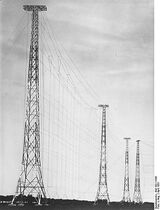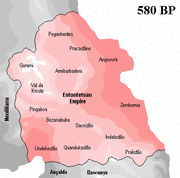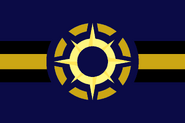| Federal Estontetsan Republic | |
|---|---|
| Conventional short name: | |
| Local: | Esto |
| Ingallish: | Estontetso |
| Data codes: | ES, EST |

| |

| |
| Languages: | |
| Official: | Gorami |
| Others: | Estontetsan, Ingallish |
| Cities: | |
| Capital: | Duceta |
| Other: | see Geography |
| Government type: | Republic |
| President: | W. S. Hombruch |
| Area: | roughly 2.25 mill. km² |
| Population: | 116 million Estontetsans (52/km²) |
| Established: | see History |
| Currency: | LU dollar = 100 lucent |
| Organizations: | see International Organisations and Treaties |
| Time zone: | VTC-1 hour (CMT-1 or -2 hours) |
| Calling code: | +26 |
Estontetso is an old-fashioned country where the good old techniques are still paramount: Steam trains, steam and sail ships, airships and electricity. There are no electronics to dominate the daily life.
When around 100AP the Kingdom was born, the people expected an era of new ways, but instead, freedom of press and sciences was increasingly suppressed, and by about 200AP, technology came to a virtual standstill. No modern technology was allowed into the country during that period which ended in the Civil War and the foreign occupation of 297AP.
What seems a disadvantage at first glance, turns out to attract millions of visitors who want to see and experience how the world of 100 years ago would function.
The name of the country means "Land of the future".[1] The autonym Esto very appropriately means "this, it".[2]
National Symbols
Star of Liliana

The Star of Liliana is an old symbol of the Liliani Empire which commenced in the region of modern Esto and in the end gave birth to this state. Therefore it is an essential part of its vexillography.
In May 321, a modernised version came into use.
Flags
see also Posts, Ranks, Standards
The modernising and multiplication of Esto's flags, decreed by the President in May 321, will continue.
In May 321, the flag (or flags) of the NEODRASTO movement became more widely known (several variants are in use); they fight for the Jalanastão Special Status Republic and several splinter territories prone to incorporation in Neoliliana or Draconia, respectively, to remain in Estontetso. They formed a border militia which they submitted to the authority and command of the Federal Constabulary.
National Anthem
The recent call for a national anthem had little response, and even the winning title was not convincing and therefore not adopted:
| "Estontetso über alles, über alles auf dem Vex..." | Melody (MID file) |
|---|
National Motto
| 321 MEINS |
|---|
The motto reflects the seizure of power by the Gorami in 321 AP, establishing the Major Estontetsan Intrinsic New System as outlined below. TECH: 3-2-1-Meins! (German for 'mine!') was a slogan of eBay.
Government
(For details see Organigramme of the Federal Estontetsan Government)
Head of State
The President of the Federal Estontetsan Republic (also called Federal President) represents Estontetso to the outside. He presides over the Supreme Parliament which acts also as Supreme Court.
Administration
There is a Secretary of State for Everything, with the necessary functional and regional offices.
Every level and branch of administration and industry is accompanied by a legislative council of the respective citzens and workforce which also functions as a court.
Posts, Ranks, Standards
See also Estontetsan military and administrative rank system.
 |
Federal President |  |
Secretary of State | ||||
 |
President of a Republic[3] |  |
Secretary of a Republic[4] |  |
Undersecretary and Executive Director[5] of a top-level governmental Office | ||
 |
Land Lord, Lord Mayor |  |
Regional Director, City Director |  |
Trust Director |  |
Constabulary Commander |
 |
Mayor |  |
Borough Director |  |
Plant Director |  |
Harbour Director |
Foreign Relations
Foreign relations are maintained by the Federal President through the Foreign Office, exchange of diplomatic missions, and participation in international organisations and treaties.
Diplomatic Missions
Ambassadors have been exchanged with the following nations:
Offers to open diplomatic relations have been sent to:
International Organisations and Treaties
Estontetso is member or signatory, respectively, of the following organisations and treaties (since):
According to the Foreign Office, applications will be submitted in due time to:
Armed Forces
See also Estontetsan military and administrative rank system.
The security of the state is maintained by the Federal Constabulary. The constabulary are proud of their structural non-aggressiveness.
- Colours indicate uniform colours; top: full dress, bottom: service dress.
- Service dress in HQs is white.
- Shoulder straps of service dress remain coloured, for details refer to Estontetsan military and administrative rank system.
- Commanders' pennants are flown on car fenders and vessels/boats.
- Equal number of stars on pennant and on shoulder straps of uniform, corresponding to common designation "1-/2-/3-star general".
Territorial Subdivisions
Estontetso is a federation of 15 Constituent Republics (Ripublicas) and 1 Federal Territory, the capital, Duceta. The basis of each of the Republics is one of the constituent peoples of the Federation. There were two types of Republics:
- Historical Republic
- whose inhabitants are ethnically a branch of one of the Three Tribes;
- Special Status Republic
- whose inhabitants are ethnically immigrants and/or refugees.
Every Republic is subdivided into regions (Pucarinas). In sum there are 66 regions and 3 Autonomous Regions (Antónias Pucarinas). The federal territory is subdivided into about a dozen boroughs.
The status of Autonomous Region was granted in former times when more than 1/5 of the population of a Republic were not part of the main ethnical group, and more than 2/3 were concentrated in a specific region. Autonomous Regions traditionally enjoy education in mother tongue. Other peculiarities had indeed been provided for, but never utilised.
From October 321, half a year after the seizure of power by an ethnic Gorami group, the concept of ethnicites became obsolete. The special status af Special Status Republics and the autonomy of the Autonomous Regions were abolished.
| Name | Code | Flag | Description | Regions | Inhabitants c. mill. | Capital | Inhabitants (in the metropolitan region) c. mill. |
|---|---|---|---|---|---|---|---|
| Angouvra | AGV | 5 | Guerunzanga | 0.75 | |||
| Bezana-Bubadera | BZB | Due to the difficulty of clearly distinguishing where one ethnical group finishes and the other one starts, historically it was the only possible solution to retain this republic as "mixed". In fact, its central position has made it a privileged meeting point of different cultures, giving this region the status of "Estontetsan Republic par Excellence". | 9 | Salingen | 1 | ||
| Botabaixo | BTB | 4, incl. Anichados Autonomous Region (21% are Kerzenhoquis, 93% of them in the Aut. Reg.) | Stockum | 1 | |||
| Duceta
(Federal Territory) |
DUC | Chosen as capital region because it is an extremely good location within a territory historically part of Bezana-Bubadera (see above). | (boroughs) | Zweibrücken | 4 (12) | ||
| Goranostr
(Special Status Republic) |
GNT | Inhabitants are ethnically Goramian, that settled the mountains after the Plague. | 5, incl. Pegasmaqui Autonomous Region (35% are Kerzenhoquis, 75% of them in the Aut. Reg.) | Oespel | 0.5 | ||
| Indacastão | ICS | 5 | Lapardana | 1 (3) | |||
| Inquantolastão | ILS | Ties with the Fenizic tribe Pralistão?[6] | 5 | Lück | 0.5 | ||
| Iparalapuqui
(Special Status Republic) |
IPA | Descendants of a former colony of Iparalaspuqui immigrants that were invited by the Emperor of Estontetso to settle this territory soon after the Plague. Ties with the Fenizic tribe of the same name | 3 | Xiripiti | 1 (3) | ||
| Jalanastão
(Special Status Republic) |
JLN | Most are refugees from former Northern Estontetso that fled when the territory fell under foreign rule, and human rights were severely violated. They were invited to occupy deserted areas along the border. | 3, incl. Salistão Autonomous Region (27% are Indacastanis, 81% of them in the Aut. Reg.) | Leumund | 1 (3) | ||
| Kerzenhoca | KZG | 4 | Eichlinghofen | 0.5 | |||
| Pralistão | PLS | Ties with the Fenizic tribe of the same name?[6] | 2 | Kirchhörde | 0.5 | ||
| Quandukastão | QDK | 6 | Holthausen | 0.75 | |||
| Ressacadatosga | RDT | 3 | Annen | 0.75 | |||
| Sacristão | SCT | 3 | Brünninghausen | 0.5 | |||
| Semprakistão | SKS | 6 | Hörde-On-Sea | 3 (9) | |||
| Zebornia | ZBM | Ties with the Fenizic tribe of the same name. | 6 | Imbedungado | 3 (9) | ||
| 2nd big harbour city: Giribalde | 2 (6) |
Geography
Position
| [TECH] Esto's... | on Earth: between... |
| Area | Argentinia / Algeria |
| Population | Japan / Philipines |
| Population density | Panama / Iran |
| Location relative to equator |
Central America & Colombia |
Estontetso stretches across the continent of Longerath, abuts five nation-states and two bodies of water. Its position is unique in that all land traffic between north and south of Longerath has to transit Estontetso, while it is the only country with coasts on both sides of the continent.
| Futuron(ian) or | Estontetsian Ocean | |||
| ||||
| Melga Bay[7] | ||||
Topography
The connection between the two oceans is hampered by the Central Longerathian Ridge which, most fortunately, offers a wide mountain pass region where the old city of Salingen is situated. From here, the mountains rise to the northwest, more steeply than to the southeast, and divide Estontetso in two parts lying towards the two oceans. The by far larger part in the northeast has Duceta as its centre, the capital of Estontetso. The topographic division is not mirrored by the ethnic distribution. The same tribal communities can be found on both sides, except for the Gorami who are only settling in the high regions of the northern Longerathian ridge, around the Val da Krosta. From this region, the two largest rivers have their source, one flowing to each ocean. TECH: names still to be given
Demographics
Of the 116 mill. inhabitants, about 45 mill. are living in urban and 70 in rural or mountainious areas.
Cities
The capital city of Estontetso is Duceta (9°23'N 21°34'W or +9.38, -21.56) with 4 mill. inhabitants in the centre and 12 mill. living in the metropolitan region. There are 3 important harbour cities and the other republic capitals; for details see table Territorial Subdivision above.
Natural Resouces
According to studies carried out by the Academy of Science, Esto counts among the top 3 Vex nations in coal, iron ore, and bauxite.
Industries
Esto is well known for its heavy industry. It counts among the top 3 Vex nations, again, in pig iron, steel products (especially rolled steel, power line cables), hydro-electric and coal power equipment and technology, in fact whole power plants, turnkey, and fine iron work (for industrial and decorative purposes).
Own sectors comprise steam locomotive works and ship-building, of both sail and steam ships, as well as transhipment equipment. Only the latter can be called faily up to date because of modern ships and aircraft entering our sea and air ports and requiring adequate handling. This might be the spark to fire up more modern industries, although the population is quite satisfied with what we have - actually, the technical interfaces to the rest of the vex are the main challenge.
With this aim, the Bundespräsident founded the Office for the Adaption to the Needs of Systems Working in Evolved Realms with Knowledge (commonly known as Ministry ANS WERK) which co-operates with several institutes of the Academy of Science.
Agriculture
Esto produces enough grains, meat, vegetables, herbs, and finest spicery to serve all demands. While coffee has to be imported on a large scale from Mennan ("Café do Begral"), tea is a speciality of the rainy western mountain slopes, with the city of Annen being the "tea capital" of central Longerath, and exported vexwide, only export to Feniz broke down after 210.
Economy
Economy is the basis of existence for the citizens and their state. In their best interest all economic entities are owned by the state and thoroughly conducted by the administration.
The citizens are free of taxs and fees. Profits are distributed to the citzens and workforce according to need and performance.
Energy
Coal mines, powerhouses, hydropower and power lines cover the low demand of electric energy and the higher demand for heating and steam power generation.
- Federal Estontetsan Energies
Transportation and Communications
Estontetso is linked to its neighbours by road, rail, ship and air, by telephone, telegraph and radio.

- Federal Estontetsan Railways FER
- The character of Esto's geography as a transit region (see above) led to a railway network which mainly provides major north-south and east-west lines, crossing in Duceta. The east-western coast-to-coast line is currently being enlarged from two to three tracks (two uphill to help express trains overtake cargo trains, one downhill), with future plans for four tracks on both main lines (one each for passenger and cargo trains in each direction).

Border Station: Assisting Class 01.5 takes over
- The high-speed Occidental Express train is planned along the whole east coast of Longerath. Lacking suitable tracks, not to mention overhead wiring, Federal Estontetsan Railways offer a transit service by assisting top-speed steam locomotives.
- The timetable of the FER is available online.
- Federal Estontetsan Shipping Lines

FEA's logo hasn't changed since the Kingdom
- Federal Estontetsan Airways FEA

Logo of Federal Estontetsan Airshipping Lines
- Federal Estontetsan Airshipping Lines ESTONTETSO DIRIGIVEIS
- The timetable of Duceta Zentralflughafen is available online.
- There is an ongoing quarrel for funds between FEA and ESTONTETSO DIRIGIVEIS.
- Federal Estontetsan Telephone and Telegraph Lines FETTL

Long Range Radio Transmitter
- The diplomatic missions are additionally connected to the Foreign Office by longwave.
- In order to catch up quickly with the technological status of the rest of the Vex in the field of computers and electronic communication, the President ordained the installation of a communications modernisation institute COMMOD for research and development which is to co-operate with the Feniz-based ISP Vexilli.Net.
Tourism
As outlined above, there is a big vexwide interest in Estontetso's "good old" technlogies. Millions of guests visit Estontetso each year for the single reason to see steam trains, steam ships, sail ships, airships and the like, and travel with them.
As these are not museums like in other countries, visitors learn to know the whole country and its beauties, and frequently come back.
The hotel business, on the same lovely old-fashioned status, is receptive on a large scale.
Focal points of tourist visits are the distinctive castles or palaces of the republics' capitals which, as a rule, houses the president, the parliament, the court and the secretariate.

Val da Krosta, or Krosta Valley, in the mountains in the west of Esto
The Val da Krosta is a vex-famous tourist resort in the region of the highest montains of the Central Longeratian Ridge.
Culture
Arts and sciences and their international exchange are liberally and amply supported.
Sports
ADDED LATER
History
Main page: History of Estontetso
The early inhabitants of Estontetso were the commonly known The Three Tribes: the Bezuntas in the north, the Empapas in the centre, and the Lambuças in the south. These three tribes divided and gave origin to the variety of peoples that make part of modern Estontetso.
In 2000 BP, the territory was divided in five kingdoms: Peganhosa, Gregurdica, Micholerdia, Burburreica and Alembida.
Micholerdia's last king Arro-Take Pexpodr IV had already lead his armies to victory over Peganhosa and northern Burburreica when he proclaimed the Liliani Empire and as Liliana's first Emperor called himself Aratacius I. His sucessors of several dynasties expanded the empire during the next millenium until it encompassed nearly all of Longerath and the Western Isles.
In 712 BP, counties in southern Liliana began a revolution against the Empire. As the Liliani Empire began to collapse, its conquered territories gradually slipped away from it, either by outright rebellion or by simply not heeding imperial decrees anymore. In 600 BP, the last Liliani Emperor, Natestus I, stopped trying to hold his far-flung empire together. In the end, Natestus was left ruling a stable and unified core nation called Empire of Estontetso.
The counties around the most powerful and central province, the "Faithful Cluster", preferred to maintain the political liaison with the Emperor Natesta. In exchange for his wish to maintain these territories under control, they demanded great power.
For about seventy-five years after its establishment, Estontetso enjoyed stability. So emboldened, it began to look outwards like Liliana had done, particularly to the north, and then to the south: the time of the Longerathian Wars.
The year 97 BP is considered when the Plague originally began on the island of Ptica, in the Demisec Islands. The first sightings of it are from around 20 BP. Gradually it spread, first to Eras and then to Longerath, peaked around 12 BP. By 3 BP, governmental and scientific leaders were beginning to realise just how terrible the Plague could become.
The Plague determined a series of migrations within the south of the territory. In that time an expedition of Iparalaspuquis accosted on the beaches, and the Emperor granted that land to settle.
Only the Krostra Valley passed uninjured through these five years of horror.
In 27 AP[8] there was a great administrative reform, with the concept of "Nation-State", the administration starting to get very centralised with the creation of the Provinces of Kerzenhoca, Bezana-Bubadera, Botabaixo and Ressacadatosga.
In 95 AP, the Empire was officially dissolved and, on October 5th 97 AP, the Kingdom of Estontetso was born. The ruling house, however, was the same, with king D. Xoninhas PanKona I and Only as head of State. The populations expected an era of freedom, a new way of ruling the country, far from the rigid and musty imperial hierarchy. but instead, freedom was suppressed.
With the failure of the kingdom, positions were extremed, the worst consequence being the breaking out of the civil war and the following foreign occupation. On January 1st 298 the People's Republic of Estontetso was proclaimed by the Revolutionary Council under General Arudian. In the Phenixian occupied area was held a referendum to decide the secession of Estontetso. The result was the union with the occupier country and becoming the Northern Phenixia Territories.
On June 27th 298 the first President of the Republic, Mr. André Serranho, was elected by popular vote. The official proclamation of the Federal Estontetsan Republic was held on November 29th 298.
Two consecutive states emerged, the Viceroyalty of Elmyra with the "benediction" of Christina and Merité, which became the Duchy of Caritas and soon vanished.
Territorial Changes
Referendums were held both in Goranostr and in Estontal (by then part of the Free Confederate Community) in order to decide their future. The outcome was very much influenced by the breaking up of the Free Confederacy, resulting in incorporation of Estontal in Estontetso, and the remaining of Goranostr province with Estontetso as well. This has still to be documented map-wise.
As the situation was regular then, People's Council of Goranostr and Ressacadatosga (where?) presented a proposal for the secession from Estontetso and joining the Federal Republic of Neoliliana and Western Gorami, while on the other side two provinces of Neoliliana have asked for joining Estontetso. Negotiations at the highest level had begun between the two governments before both participants stalled.
See also
- archived website of the Federal Estontetsan Republic TECH: by André Serranho; contents being transferred bit by bit
- ↑ Sources:
(a) old national website
(b) TECH: the only internet find "la mondo de la estontetso tiamaniere" translates to "the world of the future in this way"
(c) TECH: "Estontetso" (or Estonteco) as a whole (!) seems to mean "Future" (without "Land of"!) in Esperanto
- ↑ TECH: in Spanish
- ↑ Example: Bezana-Bubadera
- ↑ Example: Botabaixo
- ↑ each director accompanied by an equally-ranking council chairperson
- ↑ 6.0 6.1 Feniz uses a version of the Inquantolastão flag for their share of the Pralistão people: a mistake of the flag or of the people?)
- ↑ part of the Sea of Blue Waters, a marginal sea to the east of the Cislendian Ocean
- ↑ The original page says 27 BP but the context is clearly AP.































